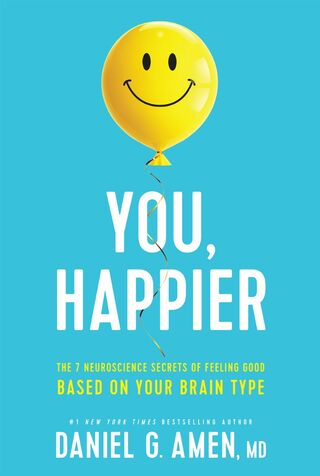Happiness
You, Happier
The Book Brigade speaks with psychiatrist Daniel Amen.
Posted March 22, 2022 Reviewed by Abigail Fagan

Everybody wants it, but fewer and fewer people seem to have it—happiness, of course. Its pursuit is even enshrined in the Constitution of the United States.
There are an awful lot of books about happiness, but they don’t seem to be making us Americans any happier. Why do you think that is?
Americans are the unhappiest they have been in decades. We were already in trouble prior to the pandemic, as suicide had increased 33 percent from 1999 to 2018, and the rates of depression and addictions had escalated. Then, of course, the pandemic, social unrest, and the political divide made everything much worse.
Why are we unhappy? Our brains and bodies are not healthy, which is one of the major ideas underlying You, Happier. Most books on happiness ignore the most important foundational principle of happiness—happiness depends on the physical functioning of the brain. After analyzing 200,000 functional brain scans and then performing a specific study on the brain and happiness, it is very clear to me that a healthier brain is critical to a happier life.
We administered the Oxford Happiness Questionnaire (OHQ) to 500 patients at Amen Clinics who also had brain scans. We then compared the scans of people who scored low in happiness on the OHQ to those who had a high score. Low happiness scores were significantly associated with lower prefrontal cortex (PFC) function. This region is the most evolved part of the human brain and is involved with focus, forethought, judgment, organization, planning, impulse control, empathy, and learning from mistakes. Low activity in this area is associated with challenges in these functions. This is a good reason why young people should not hit soccer balls with their foreheads. The PFC sits just behind the forehead.
What makes your book different from all the other books on happiness?
Most books deliver a one-size-fits-all approach to happiness, whereas my book reveals why a single set of strategies will never work for everyone. I believe that happiness depends on your brain type–basically, the concept that what makes you happy may make me miserable. I take a comprehensive approach, exploring the biology of happiness (brain types, brain health, nutrition); the psychology of happiness (mindset); the social connections of happiness (relationships); and the spirituality of happiness (focus, meaning, and purpose). In addition, I point out the lies of happiness—the things our society has brainwashed us into believing will make us happy but that actually make us more vulnerable to depression.
Your book is based on the idea of brain types. What do you mean by brain types and what are the important ones?
We discovered the brain types in performing thousands of brain SPECT (single photon emission computed tomography) scans on patients with psychiatric and neurological issues at Amen Clinics over the last 30-plus years. Our database has grown to over 200,000 brain SPECT scans.
Our brain imaging work is controversial, but we believe not looking at the brain for psychiatric indications handicaps providers and patients, and we have always believed, as do many other psychiatrists, that brain imaging is going to be a significant part of the future of mental health care. In 2021, the Canadian Association of Nuclear Medicine published new procedure guidelines for SPECT for a wide array of psychiatric and neurological indications. Over 10,000 medical and mental health patients have been referred to our 10 clinics for brain imaging to aid in diagnosis and treatment planning.
Our brain imaging research has revealed certain brain activity patterns associated with personality. We have identified brain patterns that fall into five primary categories, not unlike the Big Five: extroversion, agreeableness, openness, conscientiousness, and neuroticism). The primary types I describe are:
- Balanced—overall healthy brain activity; people tend to be focused, flexible, positive, and relaxed. They have good impulse control and tend to be conscientious and emotionally stable.
- Spontaneous—lower prefrontal cortex activity; people tend to be creative, risk taking, and love surprises, but also tend to be distracted, restless, disorganized, and impulsive. They are more likely to be diagnosed with ADHD.
- Persistent—higher prefrontal cortex activity, especially in the area of the anterior cingulate gyrus, which has been associated with shifting attention. People tend to be persistent, strong-willed, routine-oriented, and dislike surprises. They can worry, hold on to hurts, and tend to be argumentative or oppositional. These people are more vulnerable to OCD.
- Sensitive—higher activity in the limbic or emotional centers of the brain. People tend to be empathic, need close relationships with others, have had a very hard time with pandemic isolation, and are prone to pessimism and mood issues. They have a higher incidence of depression.
- Cautious—higher activity in the fear centers. People tend to be prepared, motivated, reliable, and thorough. They are usually risk-averse, dislike chaos, and can feel overwhelmed when they have too much on their to-do list. This type is at increased risk of anxiety disorders.
In our clinical practice with tens of thousands of patients from over 150 countries, we have found that many people have combinations of types, and we have identified a total of 16 brain types.
Neuroplasticity is a recognized phenomenon acknowledging that the brain has the ability to shift patterns of activity. What is the evidence that validates your typology?
Based on the findings from our database of over 200,000 functional brain images related to behavior, I think there are five primary types. And yes, through neuroplasticity, the brain can change. This is the foundation of our work at Amen Clinics. You can change your brain and change your life. This means that by following a brain-healthy lifestyle, you may arrive at a more balanced brain type.
Aside from getting a SPECT scan, how does a person know which brain type he or she is? What are the tell-tale signs?
Our team has developed a brain health assessment, a questionnaire that helps people know which of the 16 brain types they may have. We validated the questions in the assessment by comparing brain region activity to the answers to 300 questions and choosing the most predictive 38 questions.
Brain health, getting distance from the noise in one’s head, good nutrition, having values and purpose, noticing what you like about others—these are essential and well-documented strategies for happiness applicable to everyone. What does thinking in terms of brain types add?
Knowing your brain type helps you know which specific strategies are most helpful for you. For example, if you have the spontaneous brain type, goal-setting is vitally important to help you avoid distractions and stay focused. For the persistent brain type, however, setting goals and follow-through usually aren’t the problem. Learning to be a more flexible thinker and developing the capacity to change directions when necessary are more critical needs.
Your statement that most people never think about their brains made me laugh. It’s true. What should people think about their brains—how should the brain factor into everyday thinking and decision making?
Your brain is involved in everything you do and everything you are, and it is the organ of happiness. You should give your brain even more love and care than the rest of your body. With a healthy brain, you make better decisions, which will make you happier, healthier, wealthier, and more successful in relationships, work, and everything else you do. Before you make any decision, you should ask yourself, “Is this good for my brain or bad for it?”
Can you give a couple of examples of how knowing that your brain type is, say, persistent can improve your life and make you happy?
Knowing specific strategies geared to your brain type helps you enhance your brain function so you can feel happier. For example, the happiness prescriptions for the persistent type are intended to help this type overcome common traits, such as worrying, noticing what is wrong, and being a rigid thinker.
And how would knowing that your brain type is sensitive help you navigate?
Knowing that you have the sensitive brain type can point you to specific strategies to help with the issues commonly seen in this type, such as a tendency for negative thinking patterns.
What is the single most important message you want people to get out of your book?
You don’t have to win the genetic lottery to be blessed with a happy disposition. You can learn to cultivate happiness with daily practices geared to your brain type.
About THE AUTHOR SPEAKS: Selected authors, in their own words, reveal the story behind the story. Authors are featured thanks to promotional placement by their publishing houses.
To purchase this book, visit: You, Happier





